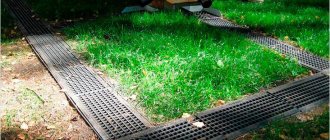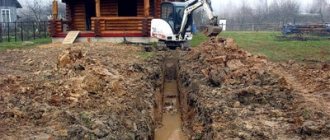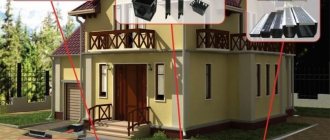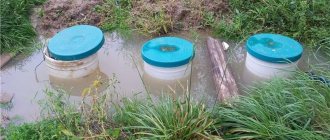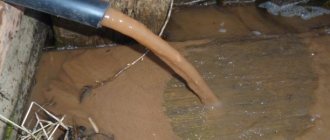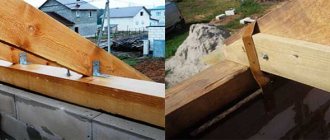28.12.2020
Groundwater
Editorial staff of the “New Place” website
Share
From this article you will learn
:
- Types of groundwater
- 3 methods for determining groundwater levels
- Danger of high groundwater level in the area
- Open drainage system equipment
- Installation of a closed drainage system
- Use of wellpoint units
- Other ways to solve the problem
- Getting rid of groundwater in the basement of a private house
- How to get rid of groundwater in a cesspool
- Protection against groundwater entering the well
- Raising the site as the most radical method of solving the problem
- Choosing a site drainage method
How to get rid of groundwater is a common question among private home owners. It is most difficult for those whose plots are located in low-lying areas. Groundwater can rise, especially during the rainy season or periods of snow melt, and flood everything around.
Fortunately, there are ways to solve the problem. Some of them are more labor-intensive, some less. You can do everything yourself, or you can with the help of specialists. The main thing is to understand in which direction to work. And only after that choose one or another solution to the problem.
Types of groundwater
When buying a plot of land on which you will build a cottage, you should take into account not only its size, but also its location. Experts advise studying the soil characteristics, as well as determining the level of groundwater. These parameters affect the complexity of construction work and arrangement of the garden. But often the owner of the land who sells it cannot answer this question. This parameter may differ, as well as their origin of groundwater.
The high water is located closest to the surface, its level is high and amounts to 50–300 cm. This water is located in the depressions between the earthen layers. High water is formed from rain, snow and condensation in the ground. If a drought occurs, the liquid evaporates. But as soon as precipitation appears, perched water forms again.
The depth of free-flowing groundwater is slightly greater. Another name for them is “pound water.” They are found at a distance of 100 to 500 cm from the surface and never disappear, even if there is a dry spell. It is free-flow water that replenishes rivers and lakes. They can have a negative impact on buildings because they erode the foundation of the house. They have one peculiarity: the location of pound waters can change, as well as their depth.
At the maximum depth there are artesian pressure waters. It is not possible to determine their location on your own. A drilling rig is used for this; it is used during the construction of wells. Artesian waters are formed from underground sources. This liquid can be used for drinking.
How deep the groundwater is located is influenced by the topography of the site. You should also consider whether there are lakes or rivers near your area. If the area is swampy or the area is low, groundwater will be located close to the surface, at a distance of 100–200 cm or even less.
Briefly about the main thing
If the terrain of the site is unsuitable for use, and the ground is waterlogged, raise and level the relief area. Depending on its area, the problem is solved manually or with the help of heavy equipment.
Defects can be corrected in different types of areas: in a lowland, on a slope, with a hill. For lifting, different soil dumping schemes and different materials are used, depending on the intended use. In some cases (significant difference in heights), the surface level is raised with simultaneous terracing.
Ratings 0
Danger of high groundwater level in the area
What troubles can await the owner of a site where the depth of groundwater is shallow? First of all, be prepared for the fact that because of the rains, the groundwater level will rise even higher, as a result of which the street toilet, septic tank, and sewer system will be flooded. What this can lead to:
- If water accumulates in an outdoor toilet, the foundation of the building will collapse and an unpleasant odor will appear in the area. In addition, there is a high risk of spreading dangerous microorganisms.
- When sewer pipes located in the ground without protection become flooded, rust forms on them. Because of this, the sewage system will quickly fail, and you will have to spend a large sum on replacing the pipes.
- If water accumulates around the septic tank, it will not be possible to clean it, the containers will be overfilled, and the discharge of the filtered liquid into the soil will be slow. The same applies to a cesspool, the entry of groundwater into which will cause a lot of trouble.
You will have to deal with flooding if you have a cellar or inspection hole. When the groundwater is high on the site, and the owner of the house equips a cellar, a basement like a thermos greenhouse, or a thermos greenhouse itself, as well as a garage pit, he will encounter serious difficulties. The fact is that during rain or spring floods, liquid will accumulate in these places:
- It will not be possible to store homemade products, vegetables and fruits in the cellar and basement, because they will rot. In addition, the buildings themselves will begin to collapse.
- If the garage pit is wet, the tools that are usually stored there will rust. You will not be able to repair your car in the inspection pit; in addition, the foundation of the garage will collapse.
- As for the thermos greenhouse, it will be too damp in the spring months, when it is necessary to plant. This problem will also have to be dealt with.
Due to the close location of groundwater to the surface, the foundation of the house will quickly become unusable. To protect the foundation from high humidity, waterproofing material should be used.
What happens if the ground is not just wet, but the foundation of the house is actually in water? Concrete may burst, the level of the foundation will change, it will pull the walls with it, which will also crack. A large sum will have to be spent on restoring the cottage’s foundation, walls and basement. The work of tightening the walls with metal structures, as well as pouring glass and other materials under the foundation will require a lot of labor and time.
Troubles will also arise with the well. Groundwater is found throughout the area, so because of it, the liquid level in the well will increase.
If there is a well on your territory, next to which there is a cesspool or an outdoor toilet, and the groundwater lies high, it will not be possible to use well water for drinking.
It is also necessary to take into account the type of soil water and its composition. Most likely, you shouldn't drink from a well at all. Because the liquid contains too high a percentage of salts. It is prohibited to use even on farm animals. Washing with such water will also not work, since it does not remove household chemicals from the fabric well.
As for garden plantings, not everything is so simple here. Some believe that groundwater does not harm plants, but its stagnation is harmful. When the depth of groundwater is constantly changing, nothing bad will happen.
Fruit trees, shrubs and other plantings will not be able to grow normally if the GWL is high in spring and autumn. Due to increased humidity, the root system of plants will rot.
In addition, much depends on the composition of groundwater. Perhaps this liquid is from a car wash station or car service station or contains harmful emissions from a chemical plant. Such liquid will cause irreparable damage to garden plantings.
If there is groundwater on the site, how to get rid of it? In this case, you will have to equip a drainage system. It eliminates waterlogging of the area and prevents soil washout. As a result, the house will last longer and the basement will be dry. The maximum efficiency was shown by open type drainage systems: surface, trench, as well as pipe systems: closed, deep, or systems using wellpoint systems. Next, let's look at the features of each of them.
On clay soils
Not all types of soil drain water well. These include clayey ones. Clay soil is characterized by an excess of moisture. Because of this, the required amount of oxygen does not reach the roots. As a result, the plants die. Dense turf also leads to oxygen starvation of plants.
When arranging a drainage system for a small area, it is not necessary to make calculations during the design process. In this case, it is necessary to take into account the parameters regarding drains:
- slope;
- location according to plan;
- depth;
- distance between rows;
- arrangement of wellhead and inspection wells.
It is better to use the natural terrain of the site with a slope when constructing a drainage system.
Using terrain
Laying in clay soil
It is easier to work with a sloping area than with a flat one. This is due at least to a reduction in labor costs. All you need is to correctly combine open and closed drainage.
Open drainage system equipment
An open drainage system is the best solution if you are looking for a way to get rid of groundwater. With its help, it will be possible to drain melt and rain water where it accumulates. An open drainage system is divided into two types: point and linear. In the first case, the system is installed under drains, watering taps, and also where it is necessary to quickly remove accumulated liquid. Drainage systems of the second type are made in the form of channels with a container for collecting moisture. Many homeowners combine these two types of drainage.
To equip an open drainage system, you will need:
- concrete, crushed stone or PVC to make channels;
- protective and decorative grilles;
- storm water inlets with holes for drainage of liquid. These tanks are used for point drainage; they are located under drainpipes. Storm water inlets are made of polypropylene or polymer concrete;
- storm flaps. Necessary to prevent water from returning from the container to the pipe if it rains.
Algorithm of actions:
- We will install ditches around the perimeter of the house, the depth of which is 50–60 cm and the width of 0.5 m.
- We place rainwater inlets under the gutters. It is important that the ditches are dug with a slope of 5-10 degrees to allow water to drain better. Their shape should be V-shaped or U-shaped.
- Crushed stone or polypropylene, polymer concrete or PVC channels are laid in the trenches.
- We bring the trenches to a water collection tank, a ditch or an artificial reservoir.
We hide the channels under a grate made of cast iron. Its weight and thickness depend on the load experienced.
How are land plots classified?
The procedure for raising the earth with your own hands depends on the type of site.
They are divided based on the landscape and features of the geological structure:
- Above sea level. They are located mainly in the mountains and on natural plains. The areas are characterized by frequent precipitation and low temperatures. The type of soil is different; before raising the land, geological studies are carried out.
- Below. They are located in lowlands and swamps. The nature of the soil varies, some are fertile. If it is decided to build a building so that it does not flood, the earth is raised.
- Above ground level. It has bumpy terrain and depressions that make processing difficult. The deficiency will be corrected by raising.
- Below. It is located in lowlands where water flows. To prevent the formation of a swamp, the territory is filled.
For leveling, crushed stone, clay, sand and other material are used.
Installation of a closed drainage system
To get rid of groundwater, you can also install a closed drainage system. However, before starting work, you should create a diagram that will indicate trenches for drainage pipes, as well as storage tanks and outlets. After this, you need to determine the depth of the pipes.
This work should be approached responsibly, since the drainage system should be located below the level of soil freezing in winter. Otherwise, the liquid in the pipes will turn to ice, they will burst, and as a result, the drainage will not function effectively. The depth of soil freezing depends on the climate of the area where you live.
Also study the composition of the soil in which the pipes will be located. If the soil is clayey, the freezing depth will be small. In the middle zone of our country, this parameter is 130–200 cm.
Sequencing:
1. Calculate the number of wells in the territory
. They should be around the perimeter of the building. In the case where the drainage area is straight, they are located at a distance of 15 m from each other. But when the system is branched, we place the wells at the junctions of the side branches and the main drain channel.
2. We purchase building materials and tools
. What you will need:
- Sand and crushed stone for equipping a cushion at the bottom of the trench, as well as for arranging a protective layer over the pipes. You can fill the pipes with crushed stone after laying them so that the liquid flows into the pipe faster and the soil pressure on it is reduced.
- Drainage corrugated pipes made of polyvinyl chloride or HDPE. This material is best suited for creating a closed drainage system. The service life of HDPE and PVC is quite long and amounts to 50 years. Perforated pipes, flexible and inexpensive.
- Geotextiles. To protect the pipes from contamination and gravel, we also cover the trench.
- Containers (wells). Corrugated polyvinyl chloride pipes of sufficient diameter or factory-made tanks with holes for pipes are also suitable.
- Fittings for connecting pipes: plugs, tees, adapter couplings, crosses, rotary tees. They should be selected taking into account the drainage scheme.
- Tools: earth drill, shovel, bayonet-shovel, hacksaw, construction level.
This is interesting!
Water purification for a private home: we create a universal system Read more
3. We dig trenches of the required depth, focusing on the diagram
. They must be made with a slope; it is 20–30 mm per 1 meter of trench. We carry out the central main with a slope towards the water intake. Since the volume of liquid is large, we make the slope stronger than that on the branches, namely 40–50 mm per 1 m.
4. Place geotextiles on the bottom of the trench
. It is important that the ends of the fabric remain outside the trench. We pour crushed stone on top, the layer thickness is 10–20 cm. Then we check that the slope angle meets the requirements.
5. We install pipes to the points of their connection with wells
.
6. We install wells, connect them to pipes using insulating couplings
. Apply adhesive sealant to the joint areas.
7. Fill the pipes with crushed stone, then wrap it in the edges of geotextile
. Pour sand or earth on top.
Preliminary stage
Before raising the ground level, a work schedule is drawn up, including planning, demolition of buildings, clearing the area of debris, drainage and backfill. At the preliminary work stage, topographers are invited to study the soil. They will select the material with precision.
If the top layer is good, it is removed and set aside for subsequent work. Level the area with cheap material and return the soil to its original place. The filling is carried out in the prepared space - the success of the work depends on this.
Preparation for raising the earth includes:
- Familiarization. At this stage, the soil for raising the site, its composition, holes and their number are studied. The process is short.
- Layout. The data is processed and the location of objects is determined.
- Clearing. Optional step. If there was previously a house on the territory, it is demolished, the rubble is cleared, and the garbage is removed.
If stumps were uprooted when preparing the site, the root holes will need to be filled with soil. Having cleared the area, they move on to filling.
Use of wellpoint units
Don't know how to get rid of groundwater in a garage, well or cesspool? The use of wellpoint units will solve your problem. This system is used for water reduction when laying the foundation of a house, as well as for arranging utilities underground.
The wellpoint is made in the form of a pipe made of polymer material into which the filter is built. The installation also consists of the following elements:
- collector pipes;
- dewatering pumping station;
- sand trap;
- drainage and discharge;
- drainage well.
To install the wellpoint unit, proceed as follows:
- Drill wells at a small distance from each other. Place wellpoints in them up to the groundwater level. Install a collector pipe above the ground, which will be connected to the wellpoints.
- The pumping station will pump out water, which will flow into the collector pipe, and then through the sand trap into the drain pipe, from there into the drainage well.
Setting up such a system with your own hands is quite difficult. Special equipment will be required, as well as geological and hydraulic studies of the site.
Difference from perched water
Verkhovodka is a local accumulation of groundwater located above the groundwater level. This is due to the seasonal factor and is temporary. This is precisely what makes it different.
During certain periods (for example, heavy rains or heavy snowmelt), this phenomenon is noticeable and noticeable, and during the dry period, it almost completely disappears.
The groundwater level is also subject to slight fluctuations, but not so significant, and this layer cannot completely disappear.
There is no high water on slopes and sandy areas, because in these cases there are opportunities for its natural removal.
Other ways to solve the problem
- We are setting up an artificial pond.
When the area of the territory is large enough and the site has geological features to drain it, a pond is installed. It will be possible to create an artificial reservoir only if the low area of the site with marshy soil is located on the periphery. This technology is called drainless dehumidification. However, surface drains can be made in the form of ditches. They can be decorated and turned into dry streams.The main advantage of creating an artificial pond is that you will be able to diversify your landscape design. However, you will have to constantly clean the lake or pond and pump out the water. The fact is that it will accumulate, bloom and contribute to waterlogging of the area.
- We plant moisture-loving shrubs and trees.
Using this method, you can drain the area without creating a drainage system. Such plants will naturally take up excess water using a developed root system. Evaporation will occur due to the abundant leaf crown.The effectiveness of this method is not high enough. However, if you also equip a standard drainage system, you will be able to drain the area.
But if you use only moisture-loving garden plantings to combat groundwater, this will only help in the case of a not very wet area or as a preventive measure. For example, if you have a dacha where you live only in the summer season, then you will not have to urgently deal with melt or rain water.
If you plant shrubs, trees and grasses that love moist soil, you will be able to reduce flooding of the area due to high water. The top layer of soil will dry out faster after spring floods, as well as heavy rainfalls in the fall.
What plants are best suited for these purposes? First of all, those that grow in natural conditions near bodies of water and in wetlands: willow, alder, birch. Shrubs, such as rosehip, hawthorn, and viburnum, should be planted along the border of the site. They will act as a hedge.
General information
The principle of operation of drainage on the site
The presence of a drainage system on the land plot of a country house increases the level of comfort while living in the house. Drainage protects the basement floors from dampness, the formation of cracks on the building, and paved paths, which guarantees the preservation of the landscape design on the site unchanged. It is possible not to lay drainage in rare situations.
What determines the need for drainage:
1. drainage is laid to drain water from the base of buildings. If water comes very close to the foundation, then the soil can shift and the house can “float.” This phenomenon can be found in clayey areas. If you add soil freezing to this, frost heaving may occur, as a result the house may be squeezed out of the ground.
2.drainage protects basements from flooding. With better installation of waterproofing layers, moisture will still penetrate into the house if there is a lot of it. Mold and mildew grow quickly in damp basements. Rain and snow, combining with salt solutions from the soil, are aggressive substances that corrode the structure of the foundation and walls.
3. If there is drainage and high groundwater levels, the septic tank is not in danger of being squeezed out of the soil.
4. Drainage and storm sewer together will quickly remove water from the building, preventing it from seeping underground to the foundation.
5.Drainage maintains the soil at optimal moisture; puddles will not form on the ground.
6.Abundance of water in the soil will lead to rotting of tree roots.
7. If the site is inclined, then with heavy rainfall and floods the upper fertile soil can be washed away. The water will go deep through the drainage and the soil will not be washed away.
In what situations does drainage require construction?
There are cases when the need for drainage construction is not questioned. Under what circumstances is the drainage structure shown:
1. When the site is located without a slope, drainage is required. If there is a lot of precipitation or a lot of snow melts, the water will not flow down the slope, it will stagnate in the form of puddles.
2. When the site is located in a lowland, drainage is required, because all the water will accumulate on the site, running down the slopes.
3. If the site has a strong slope, drainage is required, because water, quickly flowing down, will take with it the upper black soil layer. This flow of water should be directed deep into the drainage system.
4.If there is a clay type of soil, drainage is required because soils have low drainage capacity. Water will stagnate on the surface without penetrating into the deeper layers.
5. When water occurs underground above one meter, drainage is needed.
6. If the foundation is located too deep, close to the flow of groundwater, then with a seasonal rise in water, the base may flood.
Attention! The drainage system should be planned at the design stage. 7. When covering a large part of the area with concrete, tiles, or a lawn that has an irrigation system, drainage is required
7. When covering a large part of the area with concrete, tiles, or a lawn that has an irrigation system, drainage is required.
In most cases, a drainage system is vital. Before its construction, you should study the properties of the soil on the site.
Getting rid of groundwater in the basement of a private house
Don't know how to get rid of groundwater in a cellar or basement? In this case, to drain the room, an automatic system is installed that will remove accumulated water. How to equip it:
- We make a pit in the basement. To do this, we dig a recess 0.5 by 0.5 by 0.5 meters. Next, we concrete the walls or strengthen them with brickwork so that they do not collapse. Fill the pit with gravel, layer thickness 10 cm.
- We buy a pump, it will automatically turn on if the recess is filled with water to a certain level.
We install a pump in the pit, connect hoses to it, then take them as far as possible from the basement. If the groundwater level rises, the pit will fill first. The pump will start working and pump out the water. This method is suitable for draining basements during rising groundwater levels.
The cost of setting up this system is small; you can do it yourself, and the work and setup will not take much time. However, this method has disadvantages. Firstly, the pump will function normally until its resource is exhausted. Then you will be forced to buy a new one. Secondly, the water pumping system fights only the effect, not the cause, and eliminates flooding temporarily.
Raise the area with clay. Is it better to raise the area with clay or leveling soil?
Is it better to raise the area with clay or leveling soil?
Hello! I also decided to raise the site, it is 0.7 meters below the road, and the edge is 1.5 meters, 15 acres, in a triangle. At first I thought I’d get by, it’s not a cheap pleasure, there was no water on the site, because it’s on a slope, but the soil was wet under the grass, but it looked good, the groundwater in this area is high, 0.5-1 meters, but There is a small forest along the lower edge of the site and a stream in the center where water flows. I drove the tractor to level it, but it immediately sank, barely got out, went half a meter away! The soil appears to be loam, the water doesn’t drain away and it doesn’t look like it will dry out soon, because the weather leaves much to be desired, but construction needs to be done. The pile foundation with grillage will be 2 meters high.
I concluded from the advice to lift it right away and not put it off, the equipment won’t fit
Some suggested filling it with quarry soil, others with clay. For now I have agreed on clay, because it will be very budget-friendly (more than 1000 m3), only for diesel fuel. Bring it in, compact it and start building, there is no time for it to settle down on its own.
The question is whether this will be the best option, or whether leveling soil is better, it is a little more expensive, but as they say on the Internet, it is almost a panacea - a mixture of loamy or sandy soil and foreign impurities, such as fragments of stones, bricks, boulders. It compacts well, allows water to pass through better, and when fertilized it can be planted with something, not like clay!
Do I understand correctly, the clay will be compacted and will not allow water to pass below, so you need to make the correct slope with tamping in layers, after which you will need 10 cm of sand on top for drainage and only then a fertile layer! According to calculations, there will be 150 m3 of sand alone, which costs a pretty penny; clay, as well as leveling soil, will only cost delivery.
Leveling soil is also with layer-by-layer compaction. But it turns out to be a preparatory layer for fertility, and it won’t be more convenient to work with than with clay and dirt! Planting trees will be more convenient, not like in clay! But the water will mostly go down and disappear there slowly, which is not very good!
Drainage or drainage of water from the road is planned along the perimeter of the site, to a depth of up to a meter! Is it necessary? There will be a fence with a strip foundation that will also close it off from outside water!
How to get rid of groundwater in a cesspool
If you have started building a cesspool and noticed that dense clay soil has appeared after a layer of sandy soil or loam, you should think about it. You have stumbled upon an impermeable layer, under which there is a large volume of groundwater formed after precipitation.
How to prevent subsoil water from flooding a cesspool? First of all, a drainage system should be installed. It is a 15-centimeter trench of sufficient depth, which is located below the cesspool.
Large crushed stone is placed in the trench and a perforated pipeline or gutter is installed. Then the system is covered with geotextile, on top of which it is covered with earth.
The drainage system must be located on a slope so that groundwater flows, collects and is discharged.
If you want to get rid of groundwater in a cesspool, follow the following procedure:
- Install an insulating layer under the cesspool, and also waterproof the walls of the structure.
- Install an internal drainage circuit.
- Install a pump to pump water out of the drainage system.
When groundwater is located high enough, the above actions cannot be avoided. Otherwise, the liquid will stagnate in the cesspool, silt will form at the bottom, and the wastewater will not be able to drain. In addition to the appearance of an unpleasant odor, the contents will begin to flow out of the cesspool. It will be necessary to repair it and call the vacuum cleaners.
Please take note of some important tips. If groundwater gets into the cesspool, you may decide to build the system in another place, then you should dig a new hole only in the dry season, when there is no rain and the groundwater level is as low as possible.
Is water accumulating in the septic tank? Then it should be pumped out, leaving a little liquid. This is necessary in order to then beat the sediment under high pressure of water. By doing this you will stir up silt. Next, pump out the water from the cesspool again.
It is necessary to pour gravel onto the bottom of the structure, the layer thickness is 20 cm. This will protect the bottom from the formation of silt, which does not allow liquid to escape. It is important to periodically add special biological products with microorganisms that process organic waste.
In fact, cesspools are becoming a thing of the past. The labor and time costs for their arrangement are large, and the design will still not comply with the requirements of SanPiN. Therefore, it is recommended to install modern septic tanks instead of cesspools.
Why do you need to drain soil and storm water from the site?
The close occurrence of soil water leads to wet foundations, basements and basements. Water may accumulate in the basement or ground floor when the snow melts or after a long period of heavy rainfall, which must be removed and the room dried; the rest of the year it will be damp, moisture will settle on the structures, fungus and mold will grow, and the air will smell of mold and rot.
In winter frosts, soil saturated with moisture will freeze, compress the foundation, swell and push the building upward. In this case, cracks appear in the foundation and structures of the building; in severe cases, the structure of the house will begin to collapse.
If the area is swampy or groundwater is located very close, then plants grow very poorly on it, mosquitoes hatch, and an unpleasant odor appears. You can forget about beautiful well-groomed flower beds, beds and berry gardens.
If the soil is clayey, then after rain or snow melts, water stagnates on the surface, saturates the ground near buildings, and damages green spaces.
Protection against groundwater entering the well
Many summer residents install a well with drinking water on their property. If you do not make mistakes during work, the well will last for many years.
How to get rid of groundwater in a well in the spring? Indeed, in this case, you will not be able to drink from it from the beginning of spring until summer. The fact is that groundwater contains hazardous substances, salts, pesticides and herbicides that are used to treat agricultural plants.
A pump is used to pump out groundwater. However, this measure is temporary. How to make well water clean and increase the life of equipment:
- Protect the well with caissons and conductors . Install them at a depth where the boundary of the impermeable layer is located to prevent the penetration of groundwater.
- Also waterproof the outside of the well, restore the concrete rings, and seal the joints . Such waterproofing will prevent contaminants from getting into drinking water, in addition, the rings will not collapse.
- Install a security lock around the well. If you fill the dome with clay, the perched water and groundwater will not flow into the well.
- If necessary, install a storage well next to the well into which groundwater will be pumped . This way you can drain the area next to the well, and the collected water is used to water the plants.
We will install drainage channels in the future garden
A whole network of drainage channels is needed, they should literally encircle the area, you can even throw bridges over these channels and move along them to the main place, which will gradually drain.
Before constructing drainage channels, you need to determine which way your site slopes. After determining, try to make sure that the channels are directed exactly towards the slope. After digging them, be sure to cover them all with thick plastic film; it will protect the channels from overgrowing. Ultimately, all the channels should converge in one place, forming something like a pond, which will serve as an evaporator of excess moisture. It will be possible to draw water from it for irrigation.
Important ! The depth of the channels you dig should be no less than the depth to which the soil usually freezes in your region; for example, in the center of Russia the soil can freeze up to one meter.
If it is not possible to build a drainage pond, then at least make a drainage well, also directing all the channels from the site into it. But in this case, you will have to use a pump, which from time to time will need to pump out water from the site, draining the well.
Raising the site as the most radical method of solving the problem
Sometimes, even if the drainage system is properly arranged, groundwater will still flood the area. If the methods described above do not solve the problem, you should plan the area and fill it. The cost of the necessary work is quite high, but the effectiveness of this method is high. How to raise the site?
It is necessary to make a plan of the territory, indicate on it the level of heights, as well as how the surface aquifer is located. In addition, the thickness of the fertile layer is noted. This information is necessary to understand how to make bedding. To carry out this work, you should contact a professional, especially if the site has geological features.
This is interesting!
Equipment of a well in a private house: stages, types, secrets Read more
After this, it is necessary to demolish the old structures, remove vegetation from the territory, garden and household waste, stumps. Next, a drainage system is laid.
Then backfilling is done again. A foundation is installed along the site, which will protect the backfill soil and sand from the harmful effects of precipitation.
It is important that the filling is carried out in layers; the soil must be covered by 10–15 cm. Using a vibrating rammer, the filling must be compacted. The lower layers should be kept for 14–21 days to allow them to shrink. Next, you can fill the area with fertile soil.
How to prevent layers from mixing? Geotextiles are used for this. To secure the fill, it is necessary to plant cereal crops with a branched root system. To increase the efficiency of such a system, moisture-loving shrubs and trees are planted, as well as grasses that will absorb excess water. For example, birch, willow, rose hip, hawthorn, game, spirea are suitable.
Preparation for work
First, let's plan the area. To do this, think in advance where and what buildings will be located.
Next, we dismantle the old buildings, if any. It is also necessary to remove roots, stumps, and other debris. Ideally, the cleared and prepared area should stand for several days.
While the site is settling, we begin to create a strip foundation. It should run along the entire perimeter of your land. This is necessary so that after completion of the work the soil does not slide towards the neighbors and the result is preserved.
Then we remove the top fertile layer of soil. You can pour it somewhere nearby for now, but later you will have to return it to its place.
Choosing a site drainage method
Often, the owner of a site learns that the groundwater level is high after he has already purchased the land. In such a situation, it is necessary to quickly take measures to combat high humidity in order to avoid damage to the foundation of the house, as well as garden plantings.
Draining the area is quite simple; the main thing is to act correctly, taking into account the following features:
- soil composition;
- groundwater level, direction of their movement;
- the presence of lakes and rivers nearby the site;
- area of flooded territory;
- presence of buildings, garden plantings.
You should choose one or another method of combating groundwater, taking into account the characteristics of a particular site. For example, if it is swampy, it is worth raising it and installing an open drainage system. When groundwater is located close to the surface, a closed drainage system should be installed, a well with a pump should be made to pump out the water. This method is suitable for areas located in lowlands.
;
Groundwater
Did you find this article helpful? Share it with your friends:
We improve the soil composition
Soil with close groundwater, and especially swamp soil, is usually quite poor, and if you manage to dry it out, you will still have to improve it before you plant plants in this area. In addition, the soil needs to be checked for pH level: it is possible that the soil on the site is highly acidic. Then before winter you will need to add from 300 to 400 g of lime per square meter or the same amount of chalk, dig everything thoroughly, and in the spring measure the pH level again, and do this until the soil becomes neutral.
Next, ideally, imported soil should be poured over the existing soil. This way you will raise the area and increase its fertility.
Next, the area needs to be dug up, mixing the soil and adding dolomite flour in the amount of 300 g per hundred square meters of land. Before planting the seedlings (if planting is in the spring, then autumn fertilization is simply an ideal option), you need to add 250-300 g of wood ash per square meter, a bucket of humus and a teaspoon with a heap of superphosphate and potassium sulfate (all this for digging , even if you have to dig up the area again).
Laying a drainage channel in an area with high groundwater
What can you do to dry it out?
Since this phenomenon is not uncommon, there are several proven options for artificially lowering the water level.
All of them are associated with a significant amount of excavation work, so it is more advisable to carry them out before laying the foundation for the house at the beginning of construction.
The following methods are distinguished:
- A reservoir or pond for storing excess moisture.
- Open drainage.
- Closed drainage system.
- Construction industrial dewatering using wellpoints.
